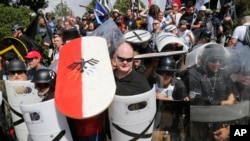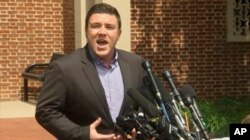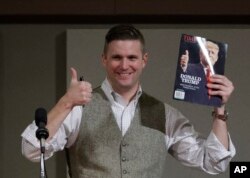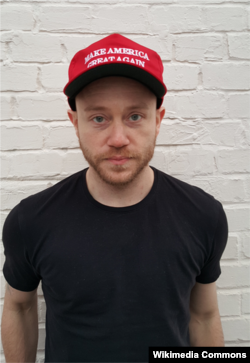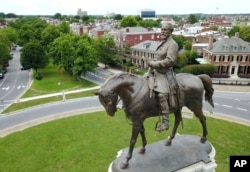Amid a tidal wave of public indignation over last weekend’s deadly protests in Charlottesville, Virginia, organizers of the white nationalist rally have taken to social media to argue that they — not the one woman killed and nearly two dozen counterdemonstrators injured — should be seen as the real victims.
“The police allowed (the counterprotesters) to rough me up because they wanted them to kill me,” rally organizer Jason Kessler said in an online video. “I’m a normal guy, and the people who went to Unite the Right rally are normal people.
“That simple notion — that we should be able to advocate for our own interests — was so offensive to the powers that be that they orchestrated a coordinated hit job,” Kessler said.
Other supporters of the white nationalist, neo-Nazi and other far-right groups that descended on Charlottesville last weekend to protest the planned removal of a statue of a U.S. Civil War general have sounded a similar theme.
But few outside the movement are buying it.
“The narrative is we’re victimized, we’re persecuted, we’re not allowed to express ourselves, even express our fundamental constitutional rights,” said Peter Simi, a sociology professor at Chapman University who studies extremist groups and violence.
Cross section of group
In truth, this narrative, employed by a cross section of white nationalist groups that are often at odds with each other, belies an ideology of ethno-nationalism that portrays whites as increasingly dispossessed and sees no place for non-whites in American society.
“I’m here to spread ideas, talk in the hopes that somebody more capable will come along and do that ... somebody a lot more racist than Donald Trump,” Christopher Cantwell, one of the scheduled speakers at the rally, told Vice News in Charlottesville.
Not everyone protesting the removal of Robert E. Lee’s statute was a neo-Nazi, and the anti-fascist — also known as antifa — counterprotesters were witnessed attacking rallygoers.
Yet despite near universal condemnation of the hatred and violence on display at Charlottesville, the white nationalist groups remain unrepentant.
“We’re not going anywhere,” Richard Spencer, a prominent white nationalist activist who was scheduled to speak at the rally, said at a press conference Monday.
Spencer has popularized the term “alt-right,” short for alternative right, to describe a broad swath of white nationalist strands.
“But if you look at him and what his beliefs represent, it’s clear that it represents white supremacy,” Simi said.
Socio-political force
Once seen as a ragtag of fringe groups, the alt-right has developed into a socio-political force in recent years, increasingly energized by the election of a U.S. president many see as an ally.
After Trump’s Nov. 8 victory, Andrew Anglin, the founder of the Daily Stormer, a white supremacist website, wrote: “Our Glorious Leader has ascended to God Emperor. Make no mistake about it: We did this. If it were not for us, it wouldn’t have been possible.”
But Stephen Bannon, Trump’s chief strategist and a former editor of the right-wing website Breitbart, dismissed the importance of the alt-right movement.
“Ethno-nationalism — it’s losers,” Bannon said in an interview with the American Prospect magazine. “It’s a fringe element. I think the media plays it up too much, and we gotta help crush it, you know, uh, help crush it more.”
It is unknown just how many members the white nationalist groups have, but all indicators — from the proliferation of right wing groups to an increase in the number of “mega hate rallies” to a rise in hate crimes — point to a substantial increase in recent years.
According to a Southern Poverty Law Center (SPLC) tally, there were 100 white nationalist groups, 130 Ku Klux Klan groups and 99 neo-Nazi groups in the United States last year.
Counting anti-government militia groups and white supremacist prison and street gangs, the movement boasts “hundreds and hundreds of thousands” of members, Simi said.
The Charlottesville rally was the largest of its kind in more than a decade and required “an unprecedented level of planning and coordination” among right wing groups, SPLC said.
Kessler appeared on right wing podcasts to hype the rally while other organizers used PayPal to raise funds.
“We’re going to do things differently in the future, no doubt, but we are going to be back in Charlottesville. One-hundred percent,” Spencer said.
Future rallies
Charlottesville officials say they don’t want the protesters back. Neither do a number of other cities where white nationalist rallies are planned for the coming days.
But small white nationalist rallies are set to take place in at least nine major cities this weekend and other cities later in August and September.
The planned rallies are “going to galvanize them,” Simi said. Canceling them, he added, is only going to feed into the white nationalist narrative of victimization, he added.
Statues a cause celebre
The removal of Confederate statues has become a cause celebre for white nationalists. While African-Americans see them as monuments to defenders of slavery, white nationalists view their removal as an assault on their cultural heritage.
Trump, who has faced criticism for vacillating in his reaction to the violence in Charlottesville, said Thursday it is “so foolish” for American cities to be removing the monuments.
The remove of the Lee statute in Charlottesville is on hold, pending litigation. But several other cities, including Baltimore, Maryland, and Gainesville, Florida, have quietly removed confederate monuments while others have announced plans to do so.
But will the white nationalists emerge empowered from the publicity-generating violence or pull back to the margins of society amid growing condemnation?
“That is difficult to say,” said George Hawley, author of Making Sense of the Alt-Right and a professor at the University of Alabama. “The images from Charlottesville were probably quite alienating to a lot of people who might have otherwise been sympathetic to the alt-right.
“On the other hand, people have declared the alt-right a dead brand before, and it has survived,” Hawley said.




